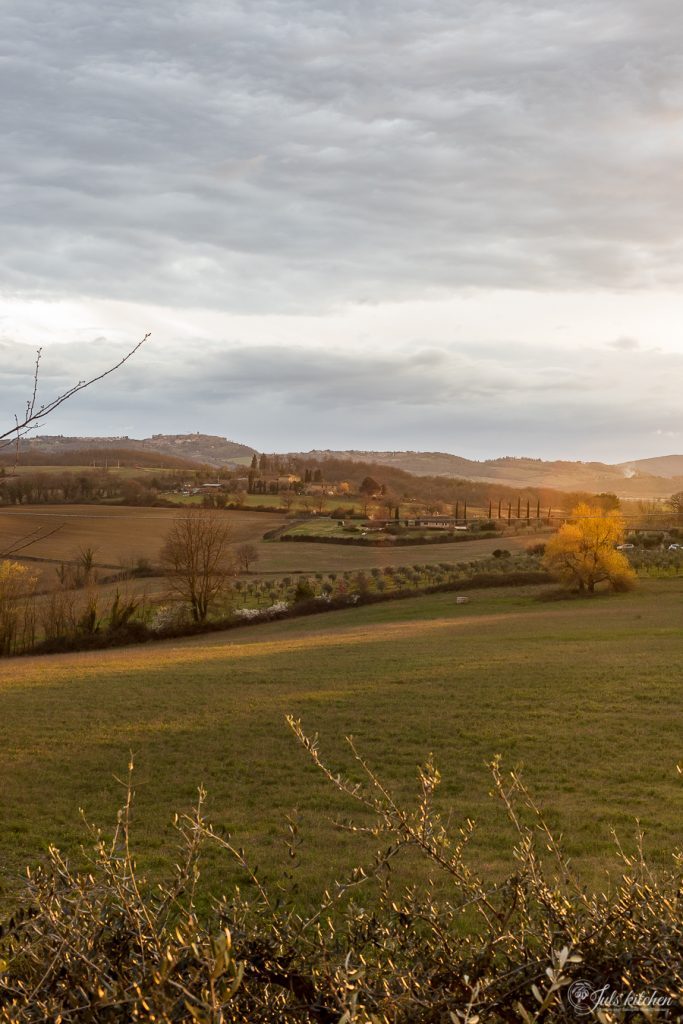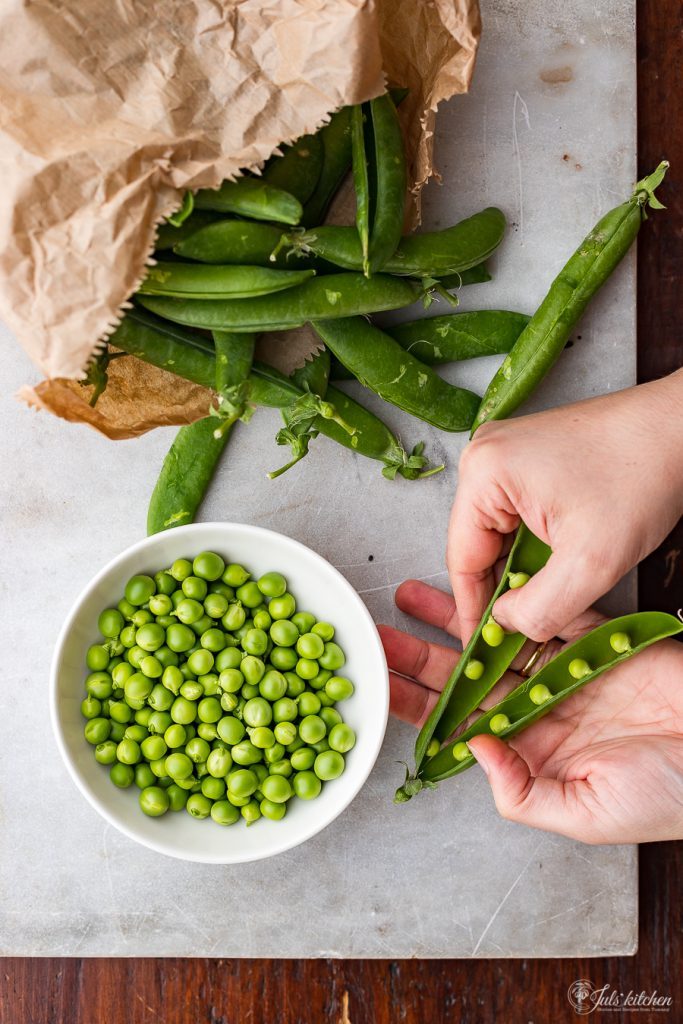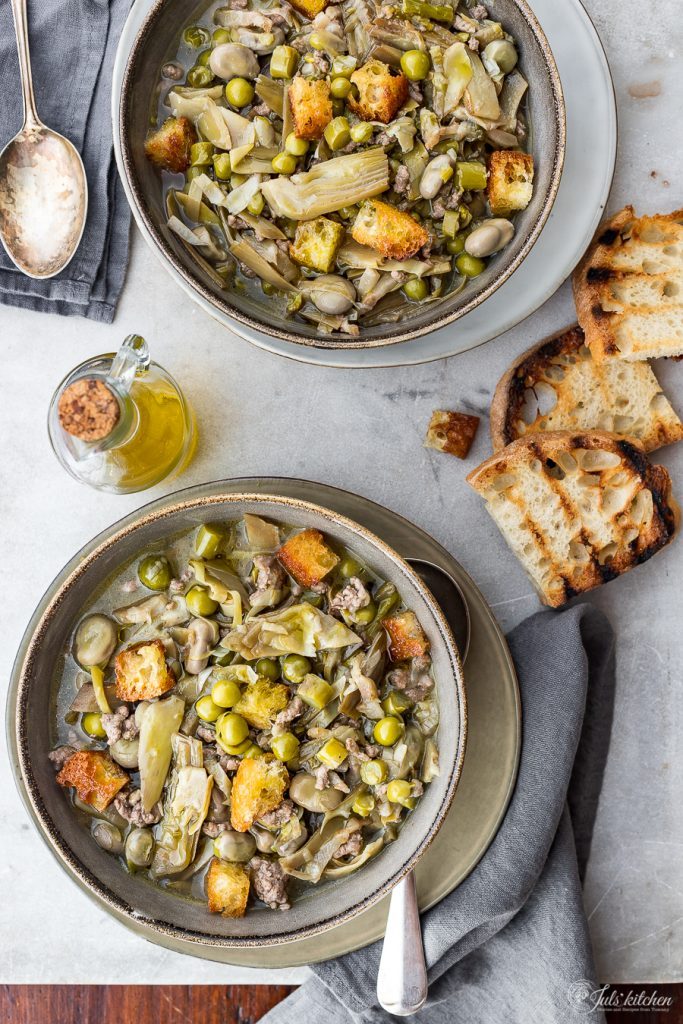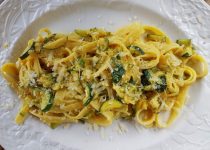Garmugia: a Tuscan spring soup that celebrates the new season
Sitting at the wooden table in the living room, I still need a sweater when the night falls. Next to me there is a glass pretending to be a vase with a withered branch of mimosa that comes from my father-in-law’s garden. I can’t throw it away: despite having lost its freshness, it still has the most joyous smell. When I inadvertently touch it, it caresses my dreams of good season, releasing its intoxicating scent, the first sign of the arrival of spring
Outside, the first long-awaited rain of the season has washed away the patina of winter: the fields sparkle with a shy green, the clouds light up with reflections, the whole countryside smiles with adolescent joy.
I feel exactly the same.
I shake away the winter numbness, I feel electricity in the air.
Winter put a boulder on my chest that made it difficult to plan bold projects: it was like I missed air, as if the creative lymph and the inspiration, that usually come from the passing of the seasons and from the pages of beautiful books, had been diverted. In their place, the empty bed of a river. Even though I have loved and embraced this slower season, this year I suffered the lack of that restlessness that anticipates new, brave projects. I missed the pitter-patter of thoughts and words that crowd into my head, impatient to spill out.
I blamed tiredness, and the long days spent at home among flu, cough and cold. Truth is, I was only afraid of throwing myself, body and soul, into an adventure that could be bigger than me, way beyond my strengths and my skills. And so discontent, resentment, and the mulling over all that I had failed to do, blocked me.
All I needed to move that boulder was a night spent talking with some friends around a table crammed with food.
Irony, a few jokes, bold ideas, dreams, not statistics. I felt like I were in a movie, or on the stage of a theatre, so effective were some of the words that actually planted seeds of reflection and hope in me.

I don’t think it is a coincidence that this happened right at the beginning of spring.
Coming home with Tommaso that day, we were silent, overwhelmed by the energy of such an evening, absorbed in our own thoughts. Later, almost inadvertently, we took up the thread of a conversation that had been going on for hours, without words. We had reached the same conclusion.
We need to slow down to accelerate, to choose our battles, to fully experience the truth and beauty of what we do. We have jotted down a battle plan – one of those that also include weekends off and afternoons spent browsing through magazines and perfecting the recipe for a sourdough bread – and we promised ourselves not to be afraid to dream big.
It was one of those moments when you realise you got to the crux of the problem, even though you still can’t focus the solution. Everything is still at an unconscious level, but I feel that I’m moving, even if I still don’t understand in which direction. I feel a tickle in my heart, a thrill of excitement: I close my eyes to savour this sensation, to keep myself from being distracted, to embrace change with every fiber of my body.
It is like when I first discovered the music of Sting when I was 18, or that of Bruce Springsteen when I was 26: it was spring both times, and those ballads, those hymns of fight and hope, those larger-than-life ideals gave me the energy to change, they put me in touch with a more real self, helping me to choose and pursue a new path.
Since then, Spring for me is all this: not only agretti and peas, hours of light and thin rain, not only the scent of flowers in the air and a lighter jacket. Spring is the season when I pick up again my dreams, feeding them with fearless fantasies, with young energy, like the green in the fields.

It all changes in unison: the recipes in the kitchen, the music I listen to, the projects I scribble on a notebook and my mood, the landscape when I drive home, words and stories. I pick up the books I loved the most, as if I were meeting old friends who had a lasting impact on my life.
The same energy flows into the kitchen and animates new recipes.
I say goodbye to butternut squash and winter numbness, I resonate with the blooming trees. I handle my dreams again, moving them from the drawer to the living room table, in between a vase of withered mimosa, a warm tea and the smell of rain in the air.
I don’t know where this renewed energy will take me, I don’t even know how long it will last, but I am sure I can always find it again in the talks with a friend, in a new project with Tommaso, in the evening light that floods the room from the balcony window, announcing the arrival of the good season.
Garmugia, a Tuscan spring soup from Lucca
All this new energy flowed into the kitchen, where I prepared a soup that, for me, is a hymn to spring: the garmugia from Lucca (pronounce it garmugìa).
Unlike many other recipes of Tuscan cucina povera, this soup – a main course if you look closely at the ingredients – belongs to the cuisine of the noble class: in the garmugia there are the first vegetables of the season, but also pancetta and ground beef.
The garmugia was born as a restorative soup after the winter ailments, recommended to those who were recovering, or to the women who had recently given birth. After the winter I spent, this is definitely the most suitable dish to celebrate the new season.
We talk a lot about micro-seasonality, about ingredients that appear – or should appear – on the market stalls only for a few days: agretti, fava beans and fresh peas, for example.
The garmugia, which resembles the Roman vignarola, is one of those recipes that can be made just for a very short time of the year, when you find fava beans, peas, asparagus and artichokes on the market stalls. It is a soup that depicts spring with its soft colours. Cook the garmugia often and in large quantities when these ingredients are in season, as then you will have to wait another year to be able to taste it again.


Garmugia, the Tuscan Spring soup
It is a soup that depicts spring with its soft colours. Cook the garmugia often and in large quantities when these ingredients are in season, as then you will have to wait another year to be able to taste it again. CourseMain CuisineTuscan Prep Time20 minutes Cook Time40 minutes Total Time1 hour Servings people
Ingredients
- 2 spring onions
- Extra virgin olive oil
- 50 g (1 ¾ oz) of pancetta
- 150 g (5 ¼ oz) of ground beef
- 120 g (about 1 cup) of shelled fava beans
- 100 g (about 1 cup) of shelled peas
- 100 g of asparagus, about 10 asparagus
- 4 artichokes
- 1 liter of vegetable broth
- 4 slices of stale bread
- salt
- Freshly ground black pepper
Instructions
- Start with the vegetables, so that they will be ready when you must add them into the soup.
- Shell the fava beans and the peas and cut the asparagus into thin rounds, leaving the tips whole. Clean the artichokes and slice them thinly, brushing them with some lemon juice to prevent them from turning black.
- Slice the spring onions thinly, including the green part. Collect the spring onions in a large saucepan with a few tablespoons of extra virgin olive oil and the pancetta, cut into strips.
- Sauté the onions for a few minutes, then add the minced meat. Stir with a wooden spoon to break it into small crumbs and to cook it evenly.
- When the meat begins to sizzle, add all the vegetables, stir thoroughly and cover them with the warm broth.
- Season with salt and pepper and cook over medium-low heat, covered, for about half an hour, until the vegetables are tender but not mushy.
- Meanwhile cut the stale bread into cubes and toast it in a pan with a drizzle of olive oil.
- Serve the garmugia with the toasted croutons, ending with a drizzle of your best extra virgin olive oil.
Serve the garmugia with…
Today I chose this menu browsing through the blog archive, searching for those posts and those recipes that could make me feel the warmth of spring on my skin and the excitement of the new days: along with the garmugia, a warm salad of spring vegetables with a a slice of grilled pecorino, a savoury artichoke tart, with a delicate lemon scent, and finally an apple and custard tart that I would serve during tea time, but even at the end of a Sunday lunch.
- Warm spring salad with grilled pecorino cheese. Spring and Elizabeth David’s simple words played their parts, and it became a warm salad with grilled fresh pecorino cheese, with a citrusy citronette made with olive oil and lemon as dressing. Elizabeth David, I am sure you would have loved this…
- Artichoke tart.Use it as an appetizer, sliced thin and warm, or as a main dish with a green salad and some carrot if you plan a modern and light menu. Or bake it in the form of small tartellettes and wrap them in coloured paper napkins for the picnic on the Easter Monday.
- Apple and custard tart. Spring to me is flowers, the warm and scented air and the picnics in the garden. Enjoy a slice of fragrant apple tart and feel yourself plunged in a warm, lazy spring Tuscan afternoon.



